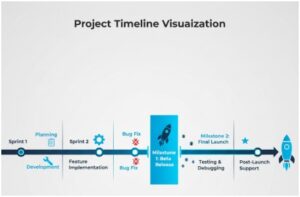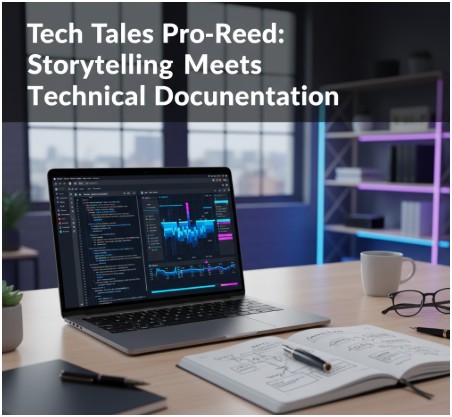I still remember the first time I had to write documentation for a project. I sat in front of my laptop, staring at a blank page, wondering how to make “Refactor module X to handle JSON streams” sound less like a grocery list and more like something my team would actually want to read.
That’s when I stumbled upon Tech Tales Pro-Reed. Suddenly, documentation didn’t have to be boring. It could be alive, funny, messy, and full of the actual story behind the work.
What Makes Tech Tales Pro-Reed Different From Regular Docs?

Most documentation feels like it was written by robots for robots. I know because I’ve written plenty of those lifeless logs myself. But Tech Tales Pro-Reed flips the script.
Instead of just stating what happened, it encourages you to write why things happened and what you felt while tackling them.
Imagine reading “How We Migrated a 15-Year-Old Codebase to React” not as a list of bullet points but as a real narrative—what broke, who panicked, and how it all finally came together.
That’s what this platform does: it blends storytelling with technical accuracy so readers walk away with both context and clarity.
And honestly? It’s the difference between someone actually reading your documentation versus pretending they did.
How Does Tech Tales Pro-Reed Support Real Projects?

When I started experimenting with Tech Tales Pro-Reed, I was impressed by the mix of tools it packed in. Code snippets weren’t just dumped in plain text—they had syntax highlighting, making it easier to share polished examples. Even better, the GitHub integration meant I didn’t have to juggle tabs while writing.
Another thing I love is the project timeline visualization. You can map out sprints, milestones, and releases in a way that feels natural and easy to follow. Instead of telling someone, “This bug fix happened around version 2.1,” you can actually show them on a timeline.
Then there are the tags. If you’ve ever searched “Kubernetes” or “Docker” across dozens of Slack threads, you know how chaotic it gets. With tagging in Tech Tales Pro-Reed, I can jump straight to the posts tied to a specific stack or tool. That alone saves me hours.
Why Should Teams Care About Tech Tales Pro-Reed?
I’ll be blunt: most teams treat documentation like an afterthought. It’s something you tack on at the end of a sprint when everyone’s already tired. But when you start telling stories about your projects, people care. Suddenly, retrospectives feel less like punishment and more like storytelling sessions.
My own team used it to capture the chaos of a migration gone wrong. Instead of just writing “server crashed during rollout,” we documented who stayed up late, how we fixed it, and what we learned. Reading it back later didn’t just jog memories—it reminded us of the teamwork that carried us through.
For educators, it’s gold. Teachers can turn dry lessons into living examples with real-world challenges. Freelancers? They can build portfolios that feel alive, not static. And for open-source folks, it’s the perfect way to explain the “why” behind a pull request.
How Do You Actually Use Tech Tales Pro-Reed?
When I first signed up, I wondered if it would feel like just another blogging platform. Spoiler: it doesn’t. Here’s how I make the most of it.
First, I start with a narrative entry. Instead of “Feature A implemented,” I write something like “The day we realized Feature A would save our sanity.” I mix in code snippets where they matter, not as filler but as proof of what I’m explaining.
Next, I lean on the timeline view. For longer projects, it helps to break the story into phases, like “prototype,” “panic mode,” and “the final launch.” That way, the story isn’t just words—it’s visually connected to the actual pace of the project.
Finally, I use tags smartly. If a project involves Kubernetes and Docker, I tag it. That way, anyone curious about my adventures in container chaos can find them instantly.
And here’s the part I didn’t expect: the AI-powered tale summarization. It’s still in beta, but it’s a lifesaver when I want to share a quick digest with teammates who don’t have time for a full read.
What Are the Benefits of Storytelling in Tech Documentation?
I used to think documentation was about accuracy. Don’t get me wrong, accuracy still matters. But storytelling adds context that pure accuracy can’t. When I write with Tech Tales Pro-Reed, I don’t just say what we built. I explain the decisions, the arguments, and even the failures.
That context makes future troubleshooting easier. It makes onboarding new team members smoother. And—bonus—it makes me want to document more because it doesn’t feel like punishment.
In a way, Tech Tales Pro-Reed helps teams build culture, not just logs. The stories remind everyone that behind every line of code, there are humans.
FAQs About Tech Tales Pro-Reed
Q: Is Tech Tales Pro-Reed only for developers?
Not at all. While it’s a dream tool for dev teams, educators and freelancers also use it. Teachers create lesson materials with real-world tech challenges, and freelancers build dynamic portfolios. Anyone with a story to tell in tech can benefit.
Q: How is it different from just writing on Medium or a blog?
Medium is great for general writing, but it doesn’t offer code integration, project timelines, or tagging for stacks. Tech Tales Pro-Reed is tailored for technical storytelling, not just writing for writing’s sake.
Q: Can I use it with my GitHub projects?
Yes! That’s one of my favorite features. You can pull in code snippets, link repos, and create context around your commits. It bridges the gap between raw code and human-readable stories.
Q: Is the AI summarization reliable?
It’s still in beta, so it’s not perfect. But honestly, it’s pretty handy. If you’ve got a long narrative, it pulls out the main beats so readers can skim without missing the essence.
Wrapping It Up With a Storyteller’s Wink
At the end of the day, Tech Tales Pro-Reed is more than a platform—it’s a reminder that tech isn’t just about code. It’s about people, mistakes, late nights, and those small wins that keep us coming back. If you’ve ever groaned at writing docs, this tool might flip that groan into a grin.
My tip? Don’t just write what happened. Write how it felt. Tech Tales Pro-Reed gives you the stage, but your voice is what makes the story worth reading.













